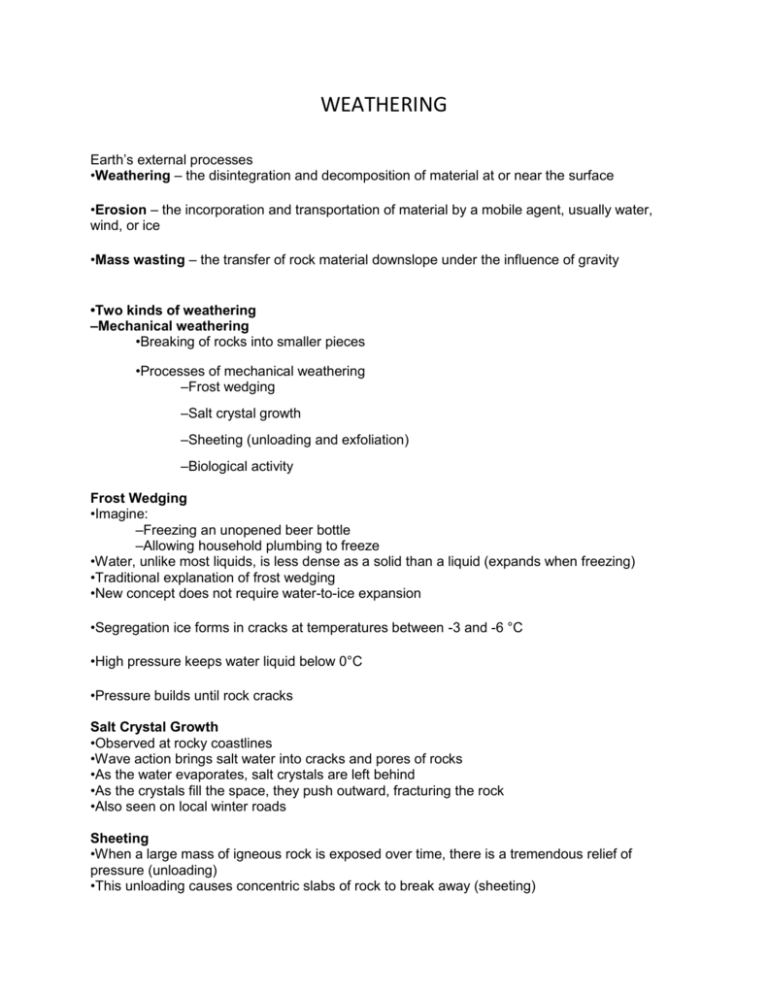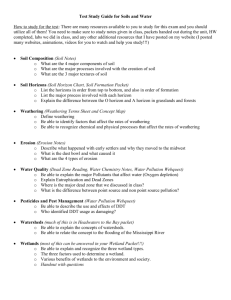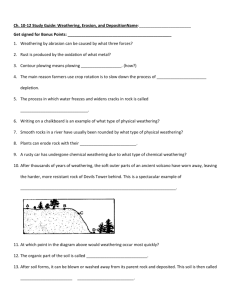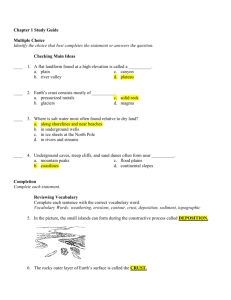WEATHERING
advertisement

WEATHERING Earth’s external processes •Weathering – the disintegration and decomposition of material at or near the surface •Erosion – the incorporation and transportation of material by a mobile agent, usually water, wind, or ice •Mass wasting – the transfer of rock material downslope under the influence of gravity •Two kinds of weathering –Mechanical weathering •Breaking of rocks into smaller pieces •Processes of mechanical weathering –Frost wedging –Salt crystal growth –Sheeting (unloading and exfoliation) –Biological activity Frost Wedging •Imagine: –Freezing an unopened beer bottle –Allowing household plumbing to freeze •Water, unlike most liquids, is less dense as a solid than a liquid (expands when freezing) •Traditional explanation of frost wedging •New concept does not require water-to-ice expansion •Segregation ice forms in cracks at temperatures between -3 and -6 °C •High pressure keeps water liquid below 0°C •Pressure builds until rock cracks Salt Crystal Growth •Observed at rocky coastlines •Wave action brings salt water into cracks and pores of rocks •As the water evaporates, salt crystals are left behind •As the crystals fill the space, they push outward, fracturing the rock •Also seen on local winter roads Sheeting •When a large mass of igneous rock is exposed over time, there is a tremendous relief of pressure (unloading) •This unloading causes concentric slabs of rock to break away (sheeting) •The end result is sometimes an exfoliation dome, with fractures called joints. –Chemical weathering •Alters the internal structures of minerals by removing or adding elements •Most important agent is water –Oxygen dissolved in water oxidizes materials –Carbon dioxide (CO2) dissolved in water forms carbonic acid and alters the material •Weathering of granite –Weathering of potassium feldspar produces clay minerals, soluble salt (potassium bicarbonate), and silica in solution –Quartz remains substantially unaltered (durable) –Weathering of silicate minerals produces insoluble iron oxides and clay minerals Rates of weathering •Advanced mechanical weathering aids chemical weathering by increasing the surface area •Important factors –Rock characteristics •Mineral composition and solubility •Physical features such as joints •Important factors –Climate •Temperature and moisture are the most crucial factors •Chemical weathering is most effective in areas of warm temperatures and abundant moisture Weathering creates ore deposits •Process called secondary enrichment –Concentrates metals into economical deposits –Takes place in one of two ways •Removing undesired material from the decomposing rock, leaving the desired elements behind •Desired elements are carried to lower zones and deposited Soil •An interface in the Earth system –Boundary between many of Earth’s systems •Soil is a combination of mineral matter, organic matter, water, and air – that portion of the regolith (rock and mineral fragments) that supports the growth of plants •Mineral source: Weathering •Proportion of soil components varies, but usually all four are present •We can define humus as the decayed organic matter derived from plant and animal remains •Humus helps greatly with water retention, due to its low density and high pore space •Soil texture and structure –Texture refers to the proportions of different particle sizes •Sand (large size) •Silt (medium size) •Clay (small size) –Loam (a mixture of all three sizes) is best suited for plant life •Soil texture and structure –Structure •Soil particles clump together in “peds” to give a soil its structure •Four basic soil structures: –Platy –Prismatic –Blocky –Spheroidal •Controls of soil formation –Parent material •Residual soil – parent material is the bedrock •Transported soil – parent material has been carried from elsewhere and deposited –Time •Important in all geologic processes •Amount of time to evolve varies for different soils, typically hundreds of years per cm of soil –Slope •Angle –Steep slopes often have poorly developed soils –Optimum is a flat-to-undulating upland surface •Orientation (direction the slope is facing) influences –Soil temperature –Moisture •Soil Profile –Soil forming processes operate from the surface downward –Horizons – zones or layers of soil –Horizons in temperate regions •O – organic matter •A – organic and mineral matter •E – little organic matter –Horizons in temperate regions •B – zone of accumulation •C – partially altered parent material –O and A together called topsoil –O, A, E, and B together called solum, or “true soil” •Classifying soils –System for classifying soils is called the Soil Taxonomy •Emphasizes physical and chemical properties of the soil profile •Names of the soil units are combinations of syllables of Latin and Greek origin •Soil erosion –A problem for agriculture –Recycling of Earth materials (natural) –Natural rates of erosion depend on •Soil characteristics •Climate •Slope •Type of vegetation –Soil erosion and sedimentation can cause •Reservoirs to fill with sediment •Contamination by pesticides and fertilizers •Solutions (read 93-100) –Wind breaks –Sustainable forestry Mass wasting •The downslope movement of rock, regolith, and soil under the direct influence of gravity •Gravity is the controlling force •Important triggering factors –Saturation of the material with water •Destroys particle cohesion •Water adds weight •Important triggering factors –Oversteepening of slopes •Unconsolidated granular particles assume a stable slope called the angle of repose •Stable slope angle is different for various materials •Oversteepened slopes are unstable –Removal of anchoring vegetation –Ground vibrations from earthquakes •Types of mass wasting processes –Generally each type is defined by •The material involved – debris, mud, earth, or rock •The movement of the material –Fall (free-fall of pieces) –Slide (material moves along a well-defined surface) –Flow (material moves as a viscous fluid) –Generally each type is defined by •The rate of the movement –Fast –Slow –Forms of mass wasting •Slump –Rapid movement along a curved surface –Occur along oversteepened slopes •Rockslide –Rapid –Blocks of bedrock move down a slope •Debris flow (mudflow) –Rapid flow of debris with water –Often confined to channels –Debris flows composed mostly of volcanic materials are called lahars •Earthflow –Rapid –Typically occur on hillsides in humid regions –Water saturates the soil –Liquefaction – a special type of earthflow sometimes associated with earthquakes •Creep –Slow movement of soil and regolith downhill –Causes fences and utility poles to tilt •Solifluction –Slow movement in areas underlain by permafrost –Upper (active) soil layer becomes saturated and slowly flows over a frozen surface below







